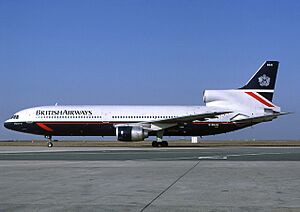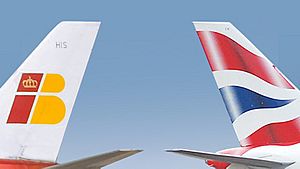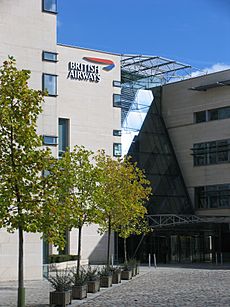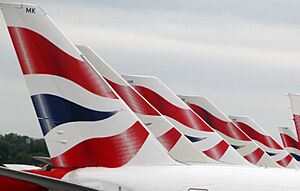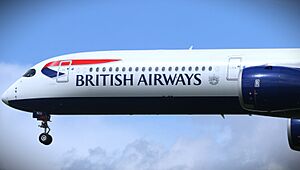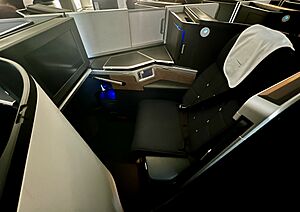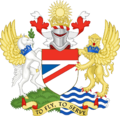British Airways facts for kids
A British Airways Airbus A350-1000
|
|
| Founded | 5 October 1916 as Aircraft Transport and Travel (AT&T) 31 March 1974 as British Airways |
|---|---|
| Commenced operations | 25 August 1919 |
| AOC # | 441 |
| Hubs | |
| Frequent-flyer program | The British Airways Club (Part of the Avios Loyalty program) |
| Alliance | Oneworld |
| Subsidiaries |
|
| Fleet size | 252 |
| Destinations | 206 |
| Parent company | International Airlines Group |
| Headquarters | Waterside London, England |
| Key people |
|
| Revenue | |
| Operating income | |
| Net income | |
| Total assets | |
| Total equity | |
| Employees | |
British Airways plc (often called BA) is the main airline of the United Kingdom. Its headquarters are in London, England, at Waterside. This is close to its main airport base, Heathrow Airport.
BA is the second-largest airline in the UK. This is based on how many planes it has and how many passengers it carries. Only easyJet is bigger. In January 2011, BA joined with Iberia. They created a new company called International Airlines Group (IAG). IAG is one of the biggest airline groups in the world. British Airways was the first passenger airline to earn over US$1 billion from a single flight route in one year. This was for flights between New York-JFK – London-Heathrow from April 2017 to March 2018.
The very first company that became part of BA was Aircraft Transport and Travel (AT&T). It started in 1916. In 1919, it began one of the world's first regular international passenger flights. In 1974, four British airlines merged to form British Airways. These were British Overseas Airways Corporation, British European Airways, Cambrian Airways, and Northeast Airlines. BA became a private company in February 1987. Over the years, it bought other airlines like British Caledonian (1987), Dan-Air (1992), and British Midland International (2012).
British Airways is a founding member of the Oneworld airline alliance. This is a group of airlines that work together. It is the third-largest alliance globally.
Contents
How British Airways Started and Grew
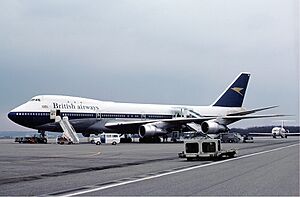
British Airways' story began with five different airlines in the UK. These airlines started between 1916 and 1922. The first was Aircraft Transport and Travel (AT&T) in 1916. AT&T started the world's first daily international flights from London to Paris in 1919.
These five airlines merged in 1924. More mergers happened in the 1930s and 1940s. This led to two large airlines owned by the government: British Overseas Airways Corporation (BOAC) from 1939, and British European Airways (BEA) from 1947.
In 1972, the British government created the British Airways Board. This board managed BOAC, BEA, and two smaller regional airlines. On March 31, 1974, all four airlines officially merged to become British Airways.
In 1976, the government changed its rules. British Airways and British Caledonian, another big UK airline, stopped competing on long-distance flights.
British Airways and Air France both flew the super-fast Concorde plane. The first supersonic passenger flight was on January 21, 1976. It flew from London Heathrow to Bahrain. Flights to the U.S. began later that year. After a Concorde crash in 2000 and the 11 September attacks, British Airways stopped flying the Concorde in 2003. The last flight was on October 24, 2003.
In 1981, the government decided to sell British Airways to private owners. Sir John King became the chairman. He helped the airline become very profitable. British Airways was sold to the public in February 1987. That same year, BA took over British Caledonian.
A new airline, Virgin Atlantic, started in 1984. This created a big rivalry with BA. There were some disagreements between the two airlines. In 1993, BA apologized and paid money to Virgin Atlantic to settle a dispute.
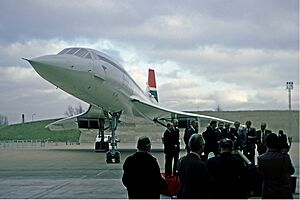
In 1992, British Airways bought Dan-Air. This gave BA a bigger presence at Gatwick Airport. In 1993, BA also bought a share in the Australian airline Qantas. In September 1998, British Airways, along with American Airlines, Cathay Pacific, Qantas, and Canadian Airlines, created the Oneworld airline alliance. This alliance started flying on February 1, 1999.
In 1998, BA started a budget airline called Go. But in 1999, BA's profits dropped a lot. Rod Eddington became the new CEO in 2000. He made some changes, including selling Go in 2001. After the 2001 attacks, fewer people flew, so BA had to cut jobs. In 2005, Willie Walsh became the new CEO.
In July 2008, British Airways and Iberia planned to merge. This merger was completed on January 21, 2011. It created International Airlines Group (IAG). IAG became one of the world's largest airline groups. As part of the merger, British Airways stopped trading as a separate company on the London Stock Exchange.
In November 2011, IAG agreed to buy British Midland International from Lufthansa. This sale was completed in March 2012.
British Airways was the official airline partner for the London 2012 Olympic Games. On May 18, 2012, it flew the Olympic flame from Athens to the UK.
On May 27, 2017, British Airways had a big computer problem. Many flights were cancelled, affecting thousands of passengers. The company said it was caused by a power supply issue.
In 2018, British Airways worked with designer Ozwald Boateng to create new uniforms. These new uniforms were launched in 2023.
In 2019, BA celebrated 100 years of flying. As part of this, four of its planes were painted in old, classic designs.
In April 2020, BA announced plans to reduce its staff by up to 12,000 people. This was because of the huge drop in air travel due to the COVID-19 pandemic. They also considered not reopening their operations at Gatwick Airport, but they did reopen there in March 2022.
In July 2020, British Airways decided to retire all its Boeing 747-400 planes immediately. They had planned to keep them until 2024. This decision was made because of the pandemic and to use more modern, fuel-efficient planes.
On October 12, 2020, Sean Doyle became the new CEO of British Airways.
In June 2024, Skytrax voted British Airways the 2024 Most Family Friendly Airline in the World. This award looks at things like seating for families, check-in, priority boarding, and meals for children.
How British Airways Works
Business Information
British Airways is the largest airline in the UK. This is based on the number of planes it has and its international flights. In 2008, it carried 34.6 million passengers. However, easyJet carried more passengers that year. British Airways has a special license that allows it to carry passengers, cargo, and mail on planes with 20 or more seats.
The airline's main office, Waterside, is in Harmondsworth, near Heathrow Airport. It was finished in 1998.
British Airways' main base is at Heathrow Airport. It also has a big presence at Gatwick Airport. Its smaller airline, BA CityFlyer, is the biggest operator at London City Airport. BA owns a large number of the flight slots at Heathrow Airport. Most BA flights use Terminal 5.
Other Companies and Partnerships
British Airways has owned many smaller companies over the years.
- BA CityFlyer: This airline was formed in 2007. It flies short routes.
- British Airways Engineering: This team takes care of maintaining and repairing all of British Airways' planes.
- BA EuroFlyer: Started in 2022, this airline helps BA compete with other airlines at Gatwick by offering lower costs.
BA also works with other airlines through agreements called codeshares. This means you can book a flight with BA, but actually fly on a plane operated by another airline. British Airways has codeshares with many airlines around the world.
Working at British Airways
Workers at British Airways are part of different unions. Pilots are represented by the British Air Line Pilots' Association. Cabin crew are represented by the British Airlines Stewards and Stewardesses Association.
There have been some disagreements between BA and its unions over the years. In 2005, some workers went on strike because of a dispute with a catering company. This caused many flight delays. In 2017, there was a long strike by some cabin crew members. They were asking for better pay and working conditions. The dispute ended in October 2017 when a new pay deal was agreed.
Where British Airways Flies

British Airways flies to over 170 places in 70 countries. This includes flights within the UK and many flights to the United States.
Airline Alliances
British Airways helped start the Oneworld airline alliance in 1999. Other founding airlines included American Airlines, Cathay Pacific, and Qantas. Being part of an alliance means airlines work together. This can make travel easier for passengers.
British Airways Planes
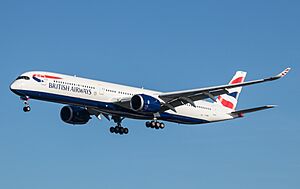
As of February 2025, British Airways has 274 planes. They also have 42 more planes on order. BA uses a mix of Airbus and Boeing planes. These include smaller planes for short flights and larger planes for long-distance travel. In October 2020, British Airways stopped using its Boeing 747-400 planes. They were one of the biggest users of the 747.
How British Airways Promotes Itself
Branding and Advertising
The music often used in British Airways adverts is "The Flower Duet" by Léo Delibes. This music has been used since 1984. For many years, BA used the slogan 'the world's favourite airline'. Other slogans have included "The World's Best Airline" and "To Fly, To Serve".
In October 2022, BA launched a new advertising campaign called "A British Original". This campaign included many different adverts and short films.
British Airways is the official airline of the Wimbledon Championship tennis tournament. It was also the official airline partner for the 2012 Summer Olympics and Paralympics in London.
High Life is the official magazine you can read on British Airways flights. It started in 1973.
Safety Videos
British Airways uses fun safety videos to show passengers what to do in an emergency. From 2005 to 2017, they used a cartoon safety video. Since 2017, they have used live-action videos with British celebrities. These videos are also part of a charity program called Comic Relief. New safety videos were launched in April 2023.
Plane Designs and Logos
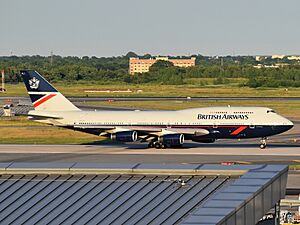
When British Airways was formed in 1974, its planes got a new white, blue, and red design. They had a Union Jack flag on their tail fins. In 1984, a new design by Landor Associates was introduced. To celebrate its 100th birthday in 2019, BA painted four planes in old designs from its history.
In 1997, there was a big change to the tailfin designs. Instead of one design, planes had many different designs. Some people, including former Prime Minister Margaret Thatcher, did not like this change. In 1999, BA decided that all planes would use the Chatham Dockyard Union Flag design on their tails. This design is based on the Union Flag.
In 2011, British Airways updated its brand. They introduced a new, shiny version of their Coat of Arms. This is used on planes, in lounges, and in adverts.
Loyalty Program
British Airways has a loyalty program called The British Airways Club. It used to be called 'Executive Club'. This program rewards people who fly with British Airways and its partners. Members earn points called 'Avios' and 'tier points'. Avios can be used for flights or other benefits. Tier points help members reach higher levels in the program. Higher levels give members benefits like access to airport lounges and faster security lines.
Members also get benefits when flying with other airlines in the Oneworld alliance.
Since April 1, 2025, 'tier points' are earned based on how much money you spend with the airline. You get 1 'tier point' for every £1 spent. You can also earn points by booking holiday packages or using certain credit cards.
What It's Like to Fly with British Airways
[[multiple image | direction = vertical | width = 220 | image1 = British Airways Airbus A319-131 Euro Traveller Cabin.jpg | caption1 = British Airways' Euro Traveller cabin, found on all of its smaller planes. | caption2 = A newer Club World seat. These seats are on most of BA's larger planes. ]]
Short Flights (within Europe)
- Economy Class
Euro Traveller is the economy class for short flights within Europe, including flights inside the UK. These flights use Airbus A320 series planes. Seats have different amounts of legroom.
On flights from Heathrow and Gatwick, you can buy food and drinks. You can order food before your flight using the British Airways app. You can also buy some items on board with a card or Avios points. Many BA planes now have Wi-Fi.
- Business Class
Club Europe is the business class for short flights. This class gives you access to special lounges at most airports. You also get free food and drinks on the plane. The middle seat in a row is left empty for more space.
Long Flights (Mid-haul and Long-haul)
- First Class
First class is available on some of BA's largest planes, like the Airbus A380s and some Boeing 777s and 787s. Each First suite is a private space with a bed that is about 6 feet 6 inches long. It also has a 15-inch entertainment screen and power outlets.
First class passengers can use special lounges, like the Concorde Room at Heathrow Terminal 5. These lounges offer waiter service and a more private space.
- Club World
Club World is the business class for long flights. The seats can turn into flat beds. In March 2019, BA introduced new Club Suite seats. These are like private rooms with a door.
- World Traveller Plus
World Traveller Plus is the premium economy class. It offers wider seats and more legroom than economy. Passengers get a larger entertainment screen, a footrest, and power sockets. They also get better food and drinks.
- World Traveller
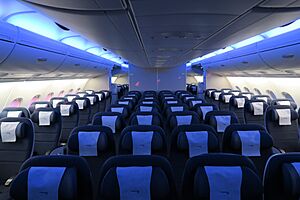
World Traveller is the economy class for mid-haul and long-haul flights. It has entertainment screens on the back of seats. Passengers get free food, drinks, pillows, and blankets. Wi-Fi is available on some planes for an extra fee.
Safety and Incidents
British Airways is known for being a very safe airline. It is often ranked among the safest airlines in the world.
Since British Airways started in 1974, it has had three incidents where a plane was badly damaged. One plane was destroyed on the ground during a war, with no one on board. There have also been two hijacking attempts. The only accident with deaths on a BA plane happened in 1976. This was a mid-air collision caused by an air traffic control error.
- On July 23, 1974, a flight from Aldergrove Airport to London Heathrow had to land in Manchester. An explosive device was found on board. Everyone got off safely.
- On November 22, 1974, British Airways Flight 870 was hijacked after taking off from Dubai. The hijackers eventually gave up after 84 hours.
- On September 10, 1976, British Airways Flight 476 crashed in mid-air with another plane near Zagreb. All 54 passengers and 9 crew members on the BA plane died. This is the only fatal accident for a British Airways plane since 1974.
- On June 24, 1982, British Airways Flight 9 flew through a cloud of volcanic ash. All four engines stopped working. The pilots managed to glide the plane out of the ash and restart the engines. They landed safely in Jakarta. No one was hurt.
- On June 10, 1990, British Airways Flight 5390 had a windscreen break during flight. The captain was partly pulled out of the plane, but the co-pilot landed it safely.
- On August 2, 1990, British Airways Flight 149 landed in Kuwait just after Iraq invaded. The plane was destroyed, and all passengers and crew were captured.
- On December 29, 2000, British Airways Flight 2069 was flying from London to Nairobi. A passenger tried to take control of the plane. The pilots fought to get control back, and the plane moved wildly. Several people were injured, but the flight landed safely.
- On January 17, 2008, British Airways Flight 38 crashed short of the runway at Heathrow. The plane was badly damaged, but no one died. The accident was caused by ice in the fuel system.
- On May 24, 2013, British Airways Flight 762 returned to Heathrow after parts of both engines broke off. A fire started in one engine. The plane landed safely with no injuries. It was found that the engine covers had not been latched properly after maintenance.
- On December 22, 2013, British Airways Flight 34 hit a building at Johannesburg airport. The wing was badly damaged, but no passengers were hurt. Four ground staff were injured.
- On September 8, 2015, British Airways Flight 2276 had an engine failure during takeoff in Las Vegas. The plane caught fire, but all 157 passengers and 13 crew got off safely.
- Between August 21 and September 5, 2018, there was a cyber attack. An attacker stole information for almost 500,000 customers, including credit card details.
- On June 18, 2021, a British Airways Boeing 787-8 had its nose landing gear collapse at Heathrow Airport. No passengers were on board.
Images for kids
See also
 In Spanish: British Airways para niños
In Spanish: British Airways para niños



